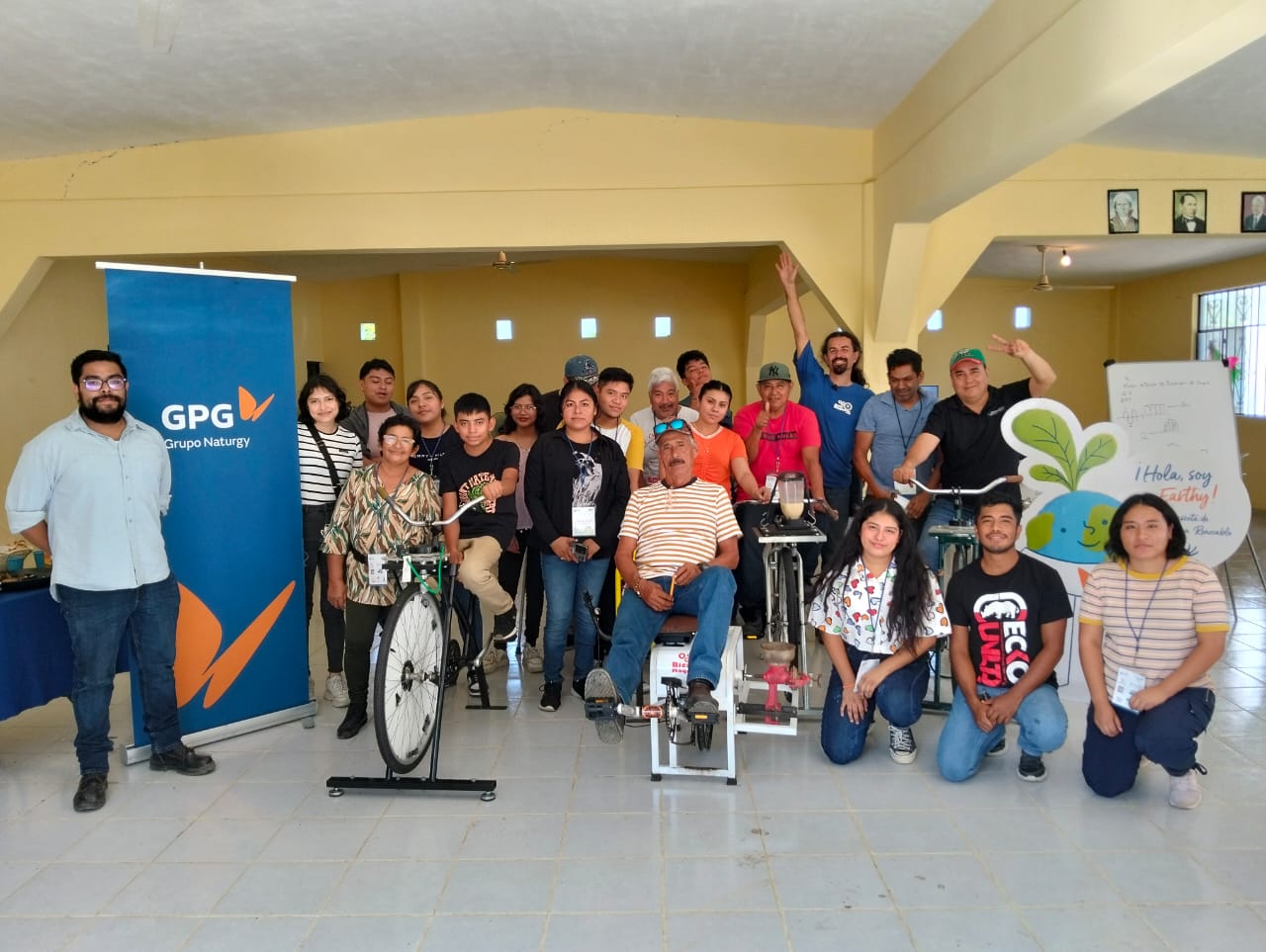On the 16 and 17 November, the fourth andlast module of the “Energy School”, organised by the Tuxpan III and IV combined-cycle power stations, took place. During this cycle of activities, 30 people participated, including Arsenio García, community agent from Práxedis Guerrero, and Mariana Castro, agent from Emiliano Zapata, as well as allies and volunteers of the communities from the Alianza de la Ruta de los Kilómetros.
To close the activities, Saúl Polino Cabañas, general coordinator of “Bici-máquinas”, presented the topic of bicycle machines and generators, corresponding to the activities of the 16th.
As for the 17th, engineer Evaristo Herrera, from the Interdisciplinary Group of Appropriate Rural Technology (GIRA) and the Regional Centre for Training and Learning (UANDANI), was in charge of presenting the topic of biodigesters.
Saturday 16, a day full of activation and energy
To start with the day’s activities, a group integration exercise was launched, which consisted of a self-assessment of the participants. For this purpose, a group dynamic was carried out in which each member wrote on a piece of paper a question related to the topics and activities addressed at the Energy School. The questions were then exchanged among the participants, who had to answer them and identify the module to which the question belonged.
After this, Saúl Polino began his participation, speaking briefly about his organisation and the different issues they deal with. He explained that the bicycle machines are pedal-powered devices that involve creative processes in which bicycle parts are adapted to make machines that can perform different tasks in a simpler way, demonstrating how these tools can transform everyday tasks.
To put what they had learned into practice, four teams were organised and had to assemble two bicycle blenders and attach them to a juice squeezer. Once the devices were assembled, the participants started pedalling, generating the necessary movement to operate both the blenders and the juice machine. As a result of this collaborative effort, a smoothie was prepared with ice, amaranth, coffee and grapefruit juice.
A bicycle mill, used for grinding corn, and a bicycle generator, which was connected to a speaker, were also built. Pedalling generated the energy needed to turn on the speaker and play music.
When it ended, a Q&A session was held in which the attendees asked Saúl about the possibilities of adapting other devices and machines to this type of system, and they shared a meal prepared by the family of Jimena Reyes Cruz, a resident of the Práxedis Guerrero community and beneficiary of the Solidarity Day scholarship.
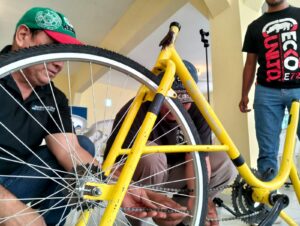
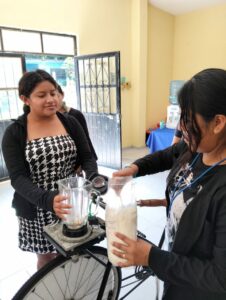
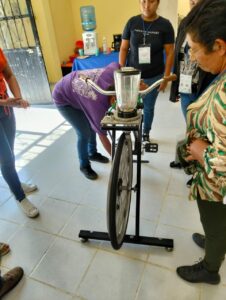
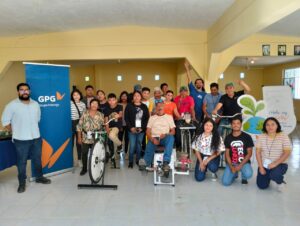
Sunday 17, a closing of the event full of teamwork and community
In order to foster community, communication, cooperation and teamwork, the rope dynamic was carried out. Participants were given a 1.50 metre long rope and, in pairs, were asked to tie a slip knot at both ends of the rope to bind their wrists, pretending to wear handcuffs. Before tying themselves together, they crossed the rope to form an “X”, so as to be joined together. Then they had to find a way to untie themselves, without cutting or untying the knots in the rope.
At the end of the exercise, participants were invited to reflect on their experience, asking them how they felt during the activity, whether they were able to maintain effective communication and how they felt about whether or not they were able to untie themselves.
Engineer Evaristo gave a talk in which he shared interesting information such as this:
- 65 million cubic metres of methane are released into the atmosphere which can be used to cook for 75 million hours a day.
- 33% of soils in Mexico are degraded due to the use of chemical fertilisers.
- What a biodigester is and how gas and bio compost or fertiliser can be generated with different organic wastes, mainly cow manure.
- The different types of biodigesters and the health and environmental benefits that can be obtained by choosing this option.
After the talk, the attendees headed over to the home of Jimena Reyes Cruz’s family where the contents were put into practice and a biodigester was installed.
Upon arrival, participants formed teams to clear the land where the biodigester was to be installed. The operation of the parts and components of the system was explained in detail, and the biodigester was assembled and filled.
The activity concluded with a Q&A session, in which questions on the proper use, monitoring and maintenance of the system were addressed. Other matters, such as the estimated time it takes to produce biogas and how to continue feeding the system in the right way were also discussed.
To conclude, a community responsibility letter was given to the attendees, in which they were asked to write how they could apply what they had learned in the four modules to the communities of the Alianza de la Ruta de los Kilómetros.
Ramadán Salazar González, in charge of RSC Latam, spoke at the closing event of the “Energy School” and presented the awards to the participants.
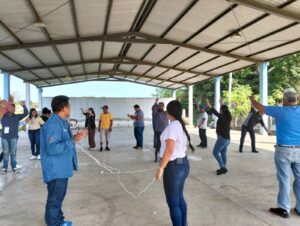
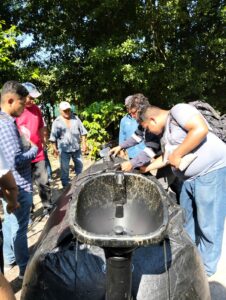
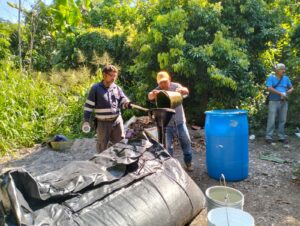
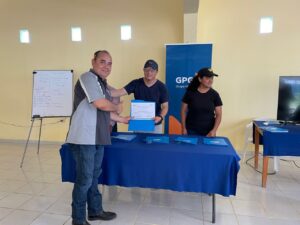
“My family and I really enjoyed the opportunity to attend the Energy School. We will look out for other chances to take part in further activities”, explained Martha Patricia, module participant.
“Many thanks to GPG for providing these types of opportunities in which we can all take part and learn new things”, stated Román Rangel, module participant..
“A year ago I had the chance to take part in the Water School and this year I didn’t hesitate to enroll in the Energy School, as some of the topics covered will be useful for the degree I am studying”, said Ángel Mendiola, module participant.


